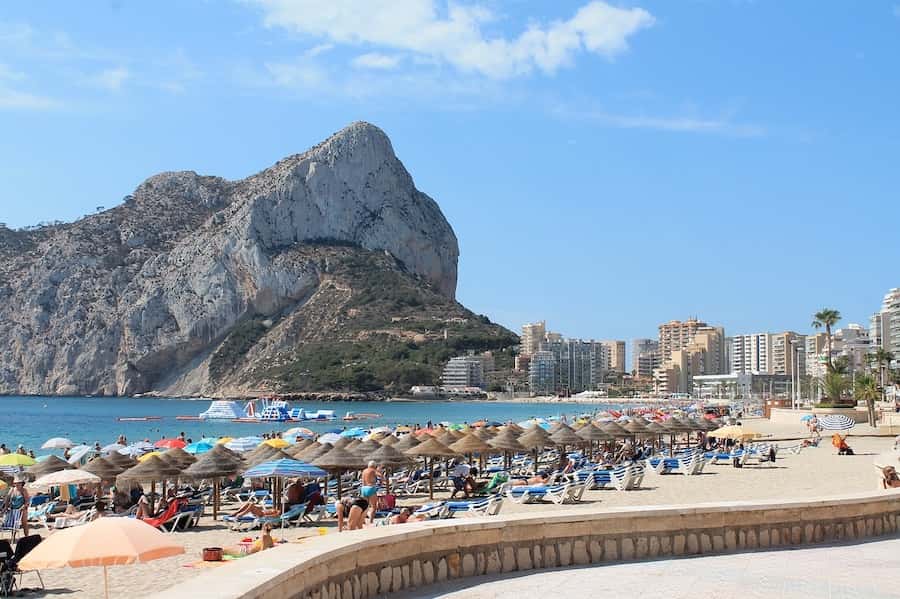The 4 best beach towns to live in the Alicante region.
Alicante offers the 4 best beach towns to live and is Spain’s most important tourist destinations thanks to its mild climate, fine sandy beaches and cultural and natural heritage. Its attractions include Santa Bárbara Castle, the Santa Cruz neighbourhood, Paseo de la Explanada, the Archaeological Museum, the Museum of Contemporary Art and The Ocean Race Museum. Also of note is the City of Light, a film complex that has hosted numerous national and international productions.
Alicante’s vast beaches make the city an ideal choice for those who wish to live close to the coast, enjoy good food and popular culture. But which are the best beach towns to live in Alicante province?
You can check the price evolution of properties for sale in Alicante in the idealista report. This will give you a general overview for a better understanding of the real estate situation in the province.
Calpe
Calpe is a town located on the north coast of Alicante province in the Marina Alta region. It is famous for Ifach Rock, an impressive 332-metre-high rock that rises above the sea and is one of the symbols of the Costa Blanca. Ifach Rock has been a natural park since 1987 and is home to a great diversity of flora and fauna, as well as archaeological remains from the Iberian and Roman periods.
It also boasts beautiful fine sand beaches and coves with crystal-clear waters, such as Levante Beach, Arenal-Bol Beach and Racó Cove. Visitors can enjoy sunbathing, swimming and water sports, and the local cuisine.
Another Calpe attraction is its salt flats, ancient salt mines dating back to Roman times, which today are a protected wetland where you can spot birds such as flamingos, herons and storks.
It also has a rich historical and cultural heritage, reflected in its monuments, such as the 18th-century castle-fortress, the 15th-century parish church of Nuestra Señora de las Nieves and the Renaissance walls.
In Calpe, the average price of houses for sale is €2,789/m2, while the average rent is €11/m2.
Dénia
Denia is the capital of the Marina Alta region. Its name comes from the Latin Dianium, which refers to the Roman goddess Diana.
It has a rich heritage resulting from the different civilisations that have lived there, such as the Iberians, the Romans, the Muslims and the Christians. Its most notable monuments include Denia castle, which has dominated the town since the 11th century; the Gothic-Renaissance La Asunción church; the 18th-century town hall and the ethnological museum, which showcases the area’s seafaring and agricultural tradition.
Marina Alta’s capital offers visitors a natural environment with over 20 kilometres of sandy and rocky beaches, hidden coves and cliffs. Montgó Natural Park, which separates Denia from Javea, is an ideal place for hiking, cycling and rock climbing. You can catch a boat to the Balearic Islands, especially Ibiza and Formentera, from Denia port.
In Denia, the average price of houses for sale is €2,479/m2, while the average rent is €9.6/m2.
Torrevieja
Torrevieja is a coastal city in the south of Alicante province, next to the Mediterranean Sea and La Mata and Torrevieja lagoons, which form an ecologically valuable natural park.
It has a long salt mining history, which was administered by the Crown from the 18th century onwards. The town’s name comes from an old watchtower that stood near the salt wharf and was half-destroyed by an earthquake in 1829.
The city offers visitors many tourist, cultural and sporting activities. Among its attractions are its fine sandy beaches, awarded with Qualitur flags, which certify their quality and cleanliness.
In Torrevieja, the average price of houses for sale is €1,746/m2, while the average rent is €9.7/m2.
Javea
This town is located on the north coast of Alicante province, in the Marina Alta region, and is an ideal place to enjoy nature, the sea and culture.
Javea has varying landscapes, from the valley between Montgó and Cape Nao to the Saladar plain and Cape San Antonio. Montgó is the most prominent peak, standing over 750 m high and protecting Javea from the northern gales. Cape Nao is the easternmost point of the Iberian Peninsula and offers spectacular views of the Mediterranean Sea.
It has over 20 kilometres of coastline, with sandy, gravel or rocky beaches and coves. Arenal Beach is the most popular and crowded, with a promenade full of services and leisure activities. Other beaches are Portichol, Granadella and Barraca or coves, such as Tangó, Ambolo or Granadella, which are ideal for diving and snorkelling.
Moreover, Javea has a rich historical and cultural heritage, reflected in its monuments, museums and festivals. The old town preserves its medieval layout, with buildings such as the San Bartolomé church-fortress, the town hall and the market. The 15th-century fishing port is home to the church of Nuestra Señora de Loreto, which has an original boat shape.
In Javea, the average price of houses for sale is €2,928/m2.
Source: Idealista. Photography by






